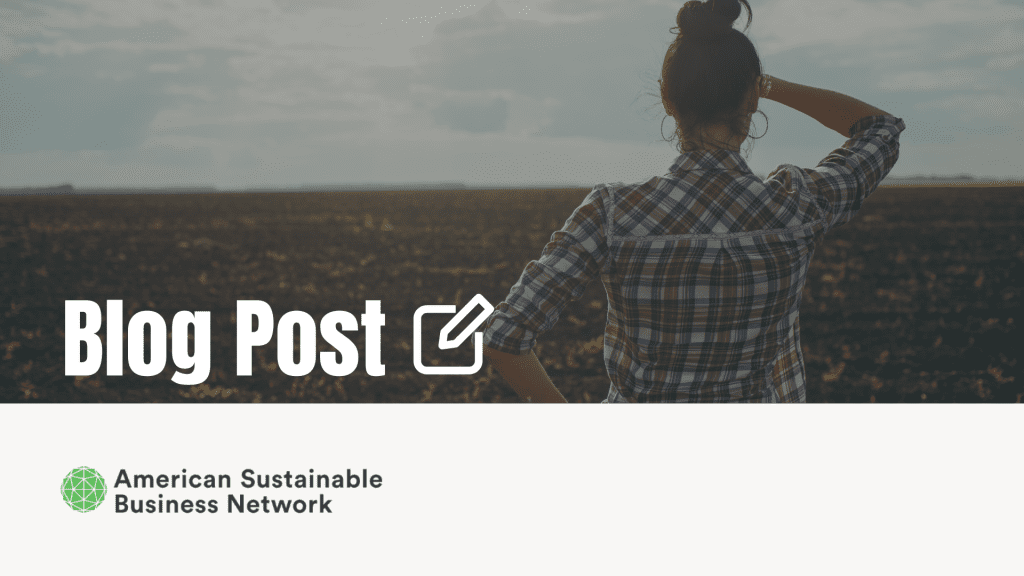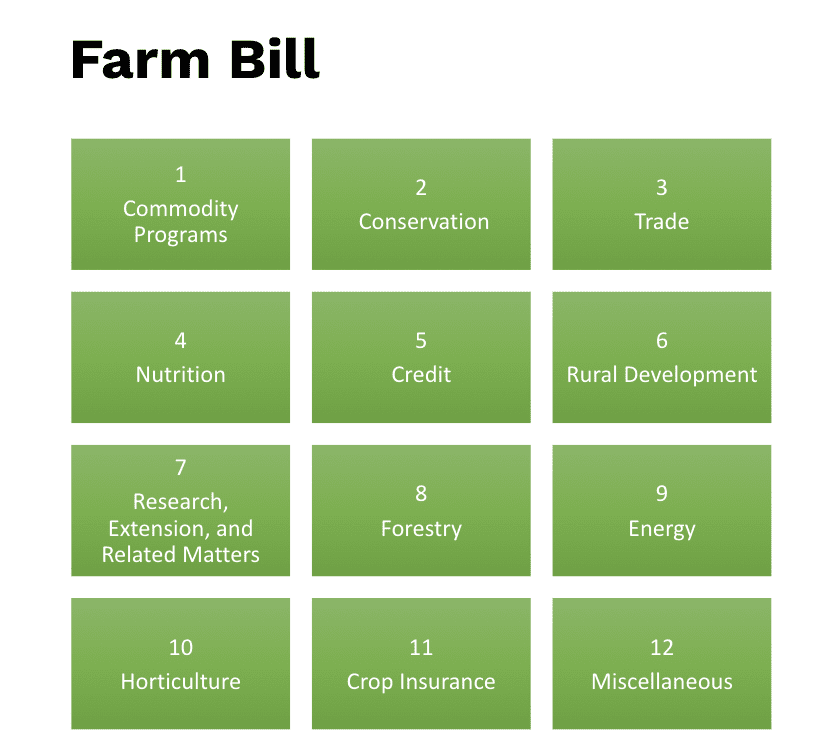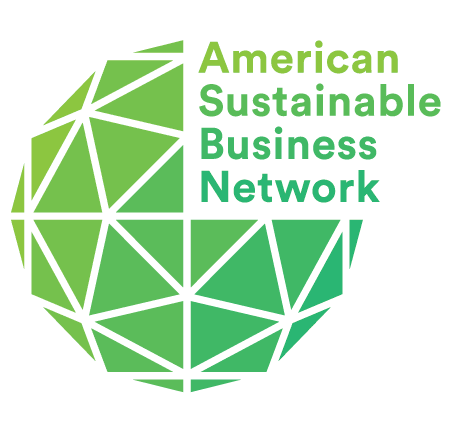
Understanding the Farm Bill – A Deep Dive into its Structure, Impact and Future
Author: Abby Maxwell Editors: Liza LaManna & Anayana White
In the first of a two-part Policy Forum Webinar, Understanding the Farm Bill – A Deep Dive into its Structure, Impact, and Future, ASBN welcomed Patty Lovera from Campaign for Family Farms and the Environment and Elliot Cordano from Rural Coalition to join a discussion with Liza LaManna, ASBN Manager of Agriculture and Water Policy. Patty and Elliot explain what the Farm Bill includes, how the timeline and programs are being shaped by the budget reconciliation process and other competing priorities of the current administration, Congress, and the American people, and how business leaders can continue to advocate for regenerative agriculture in the evolving farm bill landscape.
What is the Farm Bill?
The Farm Bill is an enormous package of legislation that sets the national policy for agriculture, food, and other related programs, which have rippling effects throughout rural and urban economies alike. The current process requires the Farm Bill to be reauthorized about every five years. However, the most recent bill was passed in 2018 and has been extended several times, with an approaching expiration on September 30, 2025. Due to its immense scope, no single person is an expert on all of the Farm Bill programs. The path to passing a Farm Bill “is a grind that moves slowly, often in inches over fairly slow periods of time,” as explained by Patty.
What’s in a Farm Bill Title?
The Farm Bill is divided into sections, called “titles”, covering a wide range of issues beyond what most people realize. The number of titles has changed over the years, but in recent Farm Bills, there have been 12 titles.

The titles span from commodity programs and nutrition, which receive a lot of attention due to the large percentage of the allocated funds that they cover, to conservation, energy, credit, horticulture, and even a section for “Miscellaneous.”
Key Farm Bill Titles and Their Focus:
These are some of the key titles that are relevant to The Campaign for Family Farms and the Environment and the Rural Coalition.
Title I, Commodity programs: covers crops including corn, soy, wheat, and dairy, all of which are specified legal commodities that drive the industrial food system.
Title II, Conservation: addresses how privately owned land is managed through government interaction, including programs like the Conservation Stewardship Program, which provides payments to farmers for implementing environmentally beneficial practices over several years.
Title IV, Nutrition: Farm Bill policy speak for the Supplemental Nutrition Assistance Program (SNAP), formerly known as “food stamps.” It is described as “one, really, of our only real social safety net programs we have left at this point [for low-income families],” as Patty explains.
Title V, Credit: Crucial for farms, which often incur huge upfront expenses before generating income.
Title VI, Rural Development: A massive source of government spending that can be spent well or can be spent badly, depending on administration priorities.
Title X, Horticulture: Covers “specialty crops” (those not classified as commodities), which many people associate with the produce we are meant to eat. Programs for organic agriculture and local food systems often fall under this title, or sometimes under Title VII: Research.
Title XII, Miscellaneous: A melting pot for issues that do not have a dedicated place among the other 11 titles. Historically, new titles are added as issues arise.
What’s Missing from the Farm Bill? Hint: Labor Rights
There are several gaps in what is covered under the Farm Bill, for historical and structural reasons that many recognize as unacceptable, and there is an ongoing policy and political fight to address these gaps. One of the most significant areas lacking protection is labor, specifically for farmworkers and other workers in the food system. Additionally, younger and nontraditional farmers are often left out of important land access and funding programs because many of the historic programs do not reflect the current agricultural landscape
“The current Farm Bill programs often leave people out now who might be younger, or earlier in their career, or from a non-traditional background,” says Patty. “Do these programs serve them? And the answer is often no, that is an opening for future advocacy in future Farm Bills.”
Lastly, immigration is an area that is complex due to the cross-jurisdictional challenge of working with other agencies, including the Department of Labor. This is an issue that has seen increased attention due to many of the policies implemented by the current Administration that specifically target undocumented farmworkers. Nearly half of farmworkers are undocumented immigrants, according to the government’s own estimates. This means they are much more likely to be the victims of workplace violations because they fear deportation if they speak up to defend their rights.
Critiquing Current Systems and Paths to Equity
Patty and Elliot explain some of the critiques of the current systems in the Farm Bill, and provide examples of alternative pathways towards equitable food systems in the future. Firstly, there is a three-decade-long shift towards extensive, concentrated, industrial livestock operations, “CAFOs” being the common acronym for Concentrated Animal Feeding Operations (AKA “factory farms”) as opposed to the small, sustainable, independent operations that Farm Bill programs initially set out to support. This shift is not an accident or based on logic, but is a policy-driven shift in who gets the majority of funding from Farm Bill programs.
Along those same lines, the extremely popular Environmental Quality Incentives Program (EQIP) is facing challenges with the types of farms they are funding with large sums of money. These grants have frequently funded infrastructure specific to the large-scale operation of factory farms. Advocates aim to change the rules for eligibility, funding amounts, and practices to redirect money more fairly to the smaller family farms that need the support of these funds.
Opportunities for Improving the Farm Bill
Advocates have identified numerous opportunities for improving the Farm Bill process and programs to prioritize equity for stakeholders and sustainability of agricultural processes, both from an economic and an environmental perspective.
Research funding, currently used to spend the majority of funds solving problems for big industry, could be diverted to address problems for a broader range of small to midsize farms and food businesses. Rural development programs, as well as initiatives that promote local foods, such as the Local Agricultural Marketing Programs (LAMP), could benefit from a closer examination of their goals and a restructuring to maximize these benefits for those they were originally intended to serve. Finally, broader reforms to financing and credit, land access and heirs’ properties, and worker protections are all goals of advocates to ensure that farmers at all stages are supported, and in turn can do the incredibly critical work of preserving the rich heritage of family farms while opening doors to new and young farmers, encouraging stewardship of local food systems and participating in thriving generationally responsible and regenerative agriculture systems.
“It is extremely hard to break into the system if you’re not inheriting land, and that ties to that other point of land access and tenure,” explains Elliot. “The Farm Bill offers this opportunity to rewrite or tweak, or modify, or even create new programs to address such issues.”
Farm Bill Historic Alliances and Current Challenges
The conventional wisdom among experts for decades has been that the Farm Bill will always pass due to the existence of necessary alliances between policymakers motivated by the nutrition programs (assistance for low-income families) and those motivated by farm programs (commodity producers, supply chain interests for corn, soybeans, dairy, etc.). In the past, this understanding resulted in a deal that allowed the massive package of legislation to pass despite its size and complexity. However, we are witnessing a breakdown of this alliance, and thus, the passing of this bill is no longer a given.
“There’s a lot of reasons this alliance is now broken down,” elaborates Patty, “But one of them is the bigger cultural, political, at-large conversation we are having about the role of the government in helping people, and the role of these nutrition programs.”
The normal timeline for a Farm Bill involves committees doing hearings, drafting bills, floor votes, and reconciliation between House and Senate versions. However, due to the breakdown of alliances and additional political pressures, Congress has struggled to reach an agreement and has instead become embroiled in intense disputes over funding for the Supplemental Nutrition Assistance Program (SNAP) versus other farm programs.
So what happens if a new Farm Bill is not passed by the extension deadline of October 1st?
As we have discussed, the 2018 Farm Bill expired in 2023 and received a one-year extension, then another for 2024, set to expire at the end of September 2025. Nothing ends immediately, although some programs will start to expire by January 1st, 2026, creating pressure for Congress to act.
Added Complications – The “One Big Beautiful” Budget
We will not get too far off track here, but sticking to the necessary information: Congress passed the so-called One Big Beautiful Budget Act over this summer, and it was signed into law on July 4th, 2025. This was a result of the budget reconciliation process, where Congress used a special procedure (called reconciliation) to pass a massive budget using only a simple majority. This made dramatic changes to the existing Farm Bill framework. The aim of the current administration was to make the 2017 tax cuts permanent, increase spending for immigration enforcement and defense, and the money was found by cutting from other programs.
One of the biggest areas of cuts came from SNAP, which typically accounts for a significant portion of funding in the Farm Bill. Cuts reached almost $300 billion and involved shifting an enormous portion of the costs of SNAP to the states, many of which are unprepared for these substantial increases in costs, signaling a strong possibility of cuts to these programs at the state level. The eligibility rules for SNAP also changed with work requirement waivers, leading to more people being subject to work requirements and thus losing their benefits. This is dramatic, both in the impact on people who are going to lose their potentially life-saving benefits, and for the impact on state budgets.
In addition to SNAP, some other programs that are normally in the Farm Bill were included in the reconciliation bill. Specifically, the programs in the “One Big Beautiful Bill” Act are those that are priorities for “Big Agriculture.” This includes commodity programs and subsidized crop insurance. Many of the programs that support local, regenerative food systems and research were not included, and thus remain up in the air as we approach the extension deadline for the existing 2018 Farm Bill.
The Farm Bill’s Unsettled Future and Tips for Staying Engaged
The normal bipartisan will to pass a Farm Bill has been eroded by the circumventing of traditional procedure that occurred when programs like SNAP were included in the massive budget reconciliation bill. This has deterred many from even coming to the negotiating table, feeling as though the line has been crossed. This makes the passing of a comprehensive Farm Bill exponentially more challenging among a very divided Congress.
“If you’ve been following what politicians specifically have been saying… historically, this has been a bipartisan effort,” says Elliot. “And so, to see the Farm Bill process circumvented through this tax package and making budgetary changes that do, down the line, have policy impacts to these different programs has left a sour taste in a lot of people’s mouths. These key pieces have been taken out, and it is going to make the next couple months increasingly complicated.”
Patty reminds us that the wheels of policy change are often slow, taking sometimes decades to see real change from advocating. She gives an example of how advocacy organizations tackled the issue of organic import fraud, from farmers blowing the whistle in 2016 to new rules being implemented around 2020-2024.
The call to action here is to remain engaged.
In the coming weeks, a lot can change. It is likely that when we get a draft of the proposed Farm Bill, there will not be a lot of time for negotiations and feedback, so we will need to be ready to respond when that time comes.
It is especially clear in this political climate that power is held increasingly concentrated by Committee leadership (in this case, the Agriculture and Appropriations committees), paying particular attention to the influence held by critical and vulnerable seats on these committees.
Now is the time to use your voice, speak up, and continue to make the case why equitable, just, and regenerative agriculture programs are important to you and to your business operations. At the American Sustainable Business Network, we will continue to work with our partners, members, and community to advocate for sustainable and responsible practices while also educating on the complexities of the current policy landscape.
The next installment in this two-part Policy Forum series, “Leveraging the Farm Bill,” is scheduled for September 10th. Join ASBN for 50% off membership until October 20th, FREE annual conference registration, and access to the next Farm Bill event!
American Sustainable Business Network (ASBN) amplifies the collective voice of sustainable business to lead the way to a regenerative economy that is stakeholder-driven, just, and prosperous. As a multi-issue, membership organization advocating on behalf of every business sector, size, and geography, ASBN works to advance its mission to inform, connect, and mobilize sustainable business leaders, transforming the public and private sectors toward a just and regenerative economy.

